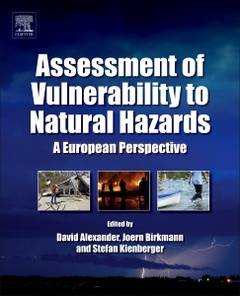Description
Assessment of Vulnerability to Natural Hazards
A European Perspective
Coordinators: Birkmann Jörn, Kienberger Stefan, Alexander David
Language: English
Subjects for Assessment of Vulnerability to Natural Hazards:
Keywords
Applied science; Conceptual framework; Disaster risk reduction; Dynamic models; Exposure; GIS methods; Holistic approach; Index building; Integrated framework; Interventions; London; MOVE framework; Portugal; Urban areas; Vulnerability; Vulnerability (meanings and redefinition); Vulnerability assessment; adaptive capacity; climate change adaptation; coastal erosion; forest fires; geon concept; heatwave; indicators; institution; integrated spatial modeling; probabilistic evaluation; regionalization; resilience; risk management; risk management index; scenarios; seismic risk evaluation; stakeholders; urban drought
240 p. · 15x22.8 cm · Hardback
Description
/li>Contents
/li>Readership
/li>Comment
/li>
Assessment of Vulnerability to Natural Hazards covers the vulnerability of human and environmental systems to climate change and eight natural hazards: earthquakes, floods, landslides, avalanches, forest fires, drought, coastal erosion, and heat waves.
This book is an important contribution to the field, clarifying terms and investigating the nature of vulnerability to hazards in general and in various specific European contexts. In addition, this book helps improve understanding of vulnerability and gives thorough methodologies for investigating situations in which people and their environments are vulnerable to hazards. With case studies taken from across Europe, the underlying theoretical frame is transferrable to other geographical contexts, making the content relevant worldwide.
Geoscientists, environmental scientists, natural hazard specialists, and social scientists. A secondary audience will include economists, public administrators, and representatives of private companies affected by hazards or with a stake in disaster risk reduction
- Provides a framework of theory and methodology designed to help researchers and practitioners understand the phenomenon of vulnerability to natural hazards and disasters and to climate change
- Contains case studies that illustrate how to apply the methodology in different ways to diverse hazards in varied settings (rural, urban, coastal, mountain, and more)
- Describes how to validate the results of methodology application in different situations and how to respond to the needs of diverse groups of stakeholders represented by the public and private sectors, civil society, researchers, and academics




